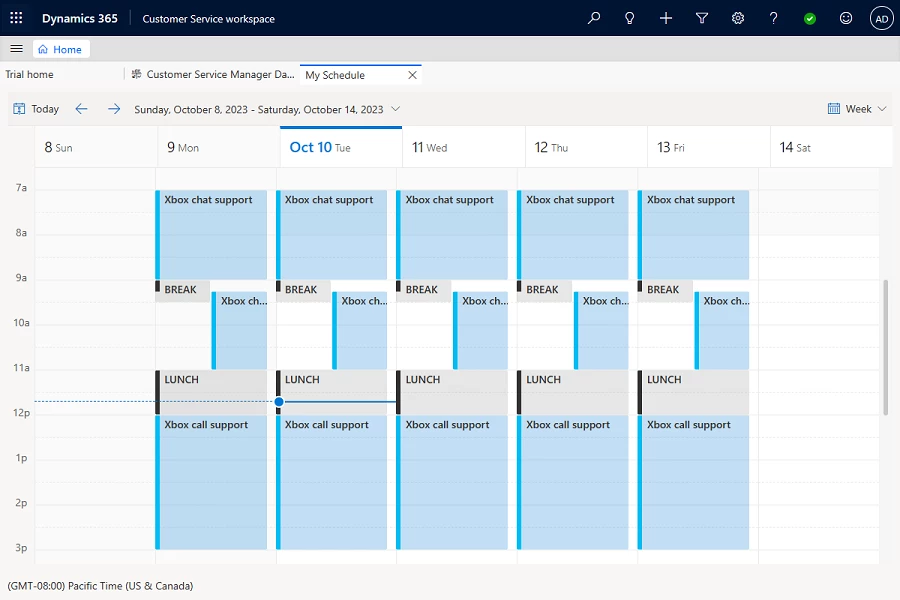
Orchestrate your WFM solution with Dynamics 365 Customer Service
A well-orchestrated workforce is the backbone of any successful customer service endeavor. This requires a systematic and holistic approach to Workforce Management (WFM), taking into account the diverse needs of customers, the fluctuating demands of the market, and the ever-changing nature of business operations.
WFM holds together the intricate machinery of customer support, ensuring operational efficiency and exceptional customer experiences. In a dynamic environment, where seamless interactions are critical, workforce management goes beyond the simple task of staffing and extends to the strategic alignment of resources, skills, and time.
Businesses choose a workforce management solution based on their unique challenges, such as compliance with labor laws. Microsoft understands that customer scenarios vary, and hence offers an open approach to incorporating the right WFM solutions. This gives customers unparalleled flexibility and efficiency in managing their workforce when using Dynamics 365 Customer Service.
WFM adapter from TTEC Digital for Dynamics 365 Customer Service
As a first step, Microsoft has partnered with TTEC Digital to offer an enhanced adapter that connects Dynamics 365 Customer Service with four leading WFM providers: Calabrio, Verint, NICE and Alvaria. The adapter is bidirectional, enabling seamless data transfer between the systems. It offers features such as real-time adherence reporting and historical reporting. Users can forecast demand on supported channels, namely inbound voice, SMS, email, chat and digital messaging, and staff accordingly.
With the enhanced adapter, organizations can use the schedule sync feature to seamlessly import schedules created in the WFM system directly into the agent calendar in Dynamics 365 Customer Service. This functionality empowers agents to conveniently review their daily schedules including breaks, training sessions, and other activities directly in Dynamics 365 Customer Service, eliminating the need to navigate to an external WFM system. This not only boosts individual performance but also contributes to overall team efficiency.

Currently, Schedule Sync is supported when using the adapter with Calabrio’s WFM system. Microsoft plans to expand support for other WFM providers.
Learn more about the WFM adapter from TTEC and watch a short video demonstration. Also, explore additional information such as pricing and buying options by checking out the TTEC WFM Adapter on Microsoft AppSource.
Connect any third-party WFM with Dynamics 365 Customer Service
The extensible nature of the Dynamics 365 platform gives organizations a publicly consumable Dataverse API. It offers maximum flexibility and customization for connecting WFM solutions with Dynamics 365 Customer Service.
For a detailed understanding including design architecture, entity details, and API specifications, please refer to this guide. Sample codes are available in the GitHub repository to expedite your journey.
What’s next
Microsoft is committed to an open and flexible approach to bringing more WFM adapters to Microsoft AppSource and enhancing the existing adapter from TTEC. Microsoft expects to offer continued API enhancements to support any third-party WFM connections.
Dynamics 365 Customer Service offers a native forecasting capability, currently in public preview. The feature empowers customers to predict both volume and demand for contact centers. We plan to enhance and expand on this capability with additional advancements, providing customers with more powerful tools for forecasting.
Stay tuned as Dynamics 365 Customer Service continues to evolve and deliver cutting-edge capabilities in WFM that anticipate and meet the ever-changing demands of the modern business landscape. Your journey to enhanced workforce management with Dynamics 365 Customer Service has just begun.
Learn more
To learn more about agent forecasting in Dynamics 365 Customer Service, read the documentation: Forecast agent, case, and conversation volumes in Customer Service | Microsoft Learn



